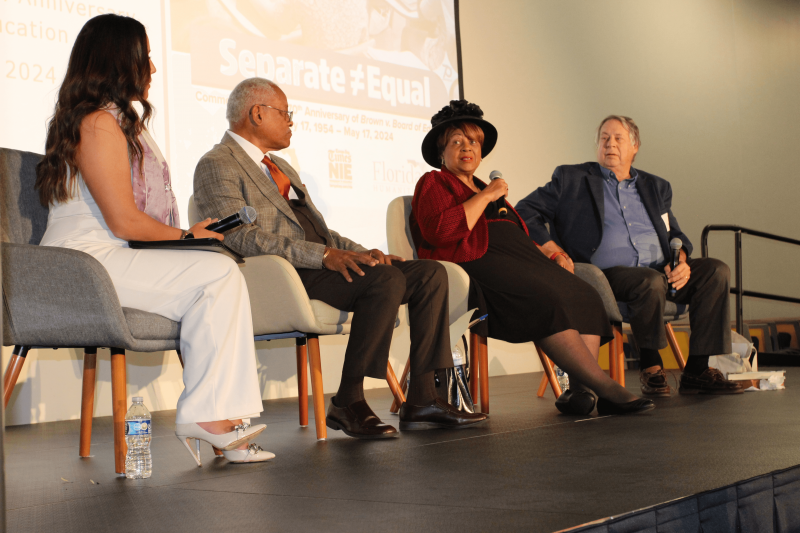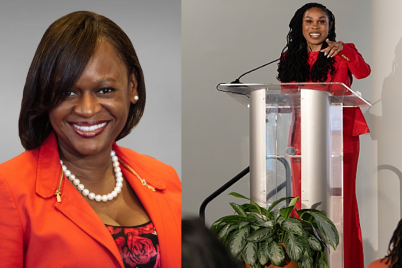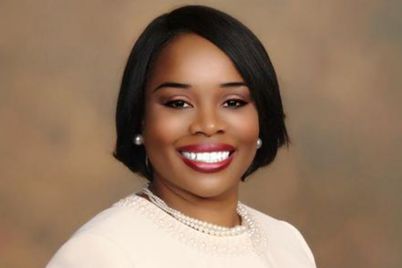The Tampa Bay Times and the Foundation for a Healthy St. Petersburg hosted a community discussion on the history and the continuing impact of Brown v. Board of Education on April 25 at the Foundation for a Healthy St. Petersburg. Pictured above are moderator Tammy Briant Spratling, Fred Hearns, Chloe J. Coney and Dr. Raymond Arsenault.
BY FRANK DROUZAS | Staff Writer
ST. PETERSBURG — One of the most pivotal court cases ever decided by the U.S. Supreme Court, Brown v. Board of Education, in 1954 began the long battle toward school integration nationwide.
In commemoration of its 70th anniversary, the Tampa Bay Times and the Foundation for a Healthy St. Petersburg hosted a community discussion on the history and the continuing impact of this landmark decision in Florida on April 25 at the Foundation for a Healthy St. Petersburg.
Dr. Kanika Tomalin, president and CEO of the Foundation for a Healthy St. Petersburg, stressed that separate educational facilities are inherently unequal, as schools for Black children often experience compromised resources such as second-hand books, broken down buses, and discarded desks left over from the white schools across town.
Seven decades after Brown v. Board of Education, the decision stands as one of the Supreme Court’s most significant acts of the 20th century, she said, and “continues to blaze a trail for the long and storied course of our country’s journey toward equity and education.”
Before this decision, the legal segregation of public services and facilities served to mitigate possibilities for people of color in our country, Tomalin explained, adding that nowhere was that travesty of oppressed trajectory more damaging than in our schools.
“We’re honored to host this gathering,” she said, “because we believe that events like these, [where] we gather to talk about the past, how it shapes our present and how it informs our future, are critical to our shared work to advance equity and improve opportunities in the community you love and call home.”
In providing historical context, Dr. Raymond Arsenault, author and John Hope Franklin professor of Southern History at USF St. Pete noted that public education wasn’t prevalent in this country until the late 19th century, and it was rigidly separated by race. At first, it was a custom of the general population segregation, and only later did it become law.

In 1950, Thurgood Marshall and the other leaders of the NAACP Educational and Legal Defense Fund argued in court that separate but equal is a contradiction in terms, said Dr. Raymond Arsenault.
“In the 19th century when public schools began,” he said, “there really wasn’t any debate about racial integration or desegregation.”
Most Black families had been in the country long enough by then to know that education was key to social mobility and enhancement of self-worth — the white supremacists who controlled the South knew that all too well, Arsenault said, explaining that they made it illegal in many cases for the enslaved to read, attend school or even congregate for discussions.
The first real attempt to fight the system of segregated schools began after the NAACP was founded in 1909. Primarily a political organization fighting for African Americans’ rights, the NAACP decided that education was the most important issue for them in the late 1920s or early 1930s, Arsenault pointed out.
Since the organization knew it would be a struggle to turn mainstream America against the 1896 Plessy v. Ferguson decision — which maintained that “separate but equal” was Constitutional — its strategy then was to attack the decision by proving that the schools were indeed anything but equal. In the 20th century, in many areas of the South, there were no Black middle or high schools at all.

The two girls in this photo are Jan and Irene Glover, ages 9 and 7. Their mother, Irvena Prymus, walked them into Orchard Villa Elementary School in Miami on Sept. 8, 1959. [State Archives of Florida]
“For the first time, many Americans began to rethink their commitment to white supremacy, to racial discrimination,” Arsenault said. “The times were really changing.”
Tampa native Chloe J. Coney, CEO of Community Enterprise Group, shared her memories of her days in the school system in the 1960s, saying that though the Black schools may not have had the best resources, the students had a “lot of love.”

‘I’m watching them sing ‘Dixie, in the land of cotton!,’ said Chloe J. Coney, CEO of Community Enterprise Group.
“Those teachers poured into us every knowledge that they knew!” she said.
When integration was put into motion in Hillsborough County, she was only 13. When she first attended high school as a freshman in West Tampa, many of her classmates had never been around Black students before, asking her all manner of questions. Just before her senior year at Jefferson High, the school closed, and she had to attend Hillsborough High School, the county’s oldest school, where she was in for a shock. Coney remembered sitting in the auditorium during pep rallies and watching the Confederate flag being waved proudly.
“I’m watching them sing ‘Dixie, in the land of cotton!'” she said. “And I said to myself. ‘Where am I?’ And can you imagine this is being sanctioned by the school system?”
A bright girl who had once been encouraged by her community — including civil rights legend Rev. A. Leon Lowry, members of Beulah Baptist Church and caring teachers — Coney found herself being called the N-word and made to sit in the back of the classroom. So, when she graduated in 1968 with honors, she told herself she’d never return to Hillsborough High again and looked forward to attending Florida A&M University.
She went on to become the first Black female probation and parole officer in Hillsborough County in 1972 and worked in the courtroom of George Edgecomb, the first Black Hillsborough County judge.
Conceding that “God has a sense of humor,” Hillsborough High School inducted Coney into its hall of fame in 2021, over five decades after she graduated.
Hearns, who attended public schools about the same time Coney did, graduated from Middleton High on the east side of Tampa in 1966. For all its faults, one thing that segregation did was promote unity among Black students, he said.
“We had to come together to survive,” said Fred Hearns, curator of Black History, Tampa Bay History Center, noting that African Americans could only go to one park in the entire city back then. “Even though we were in Tampa, 20 miles away from St. Petersburg and the beaches, we couldn’t go anywhere near the beaches.”

Fred Hearns had only one other Black student in classes during his four years at the University of South Florida.
Praising Coney and others like her, he said many success stories have come out of segregation. Hearns himself earned a bachelor’s degree in English and journalism and a master’s degree in Africana Studies at USF. He served as a newspaper journalist for publications including the Florida Sentinel Bulletin, St. Petersburg Times, Tampa Tribune and Ft. Lauderdale Sun Sentinel.
He recalled that most of his experiences at USF were good, and his best friends were Cuban and Jewish students.
“We were kind of fighting some of the same things,” Hearns said, “and we formed that close bond.”
Hearns had only one other Black student in classes during his four years at USF. During his sophomore year, about the time Dr. Martin Luther King, Jr. was assassinated, a white student invited Hearns to a party at a condo in St. Pete Beach. Hearns, 19 at the time, had never even set foot on St. Pete Beach. After about 20 minutes at the party, where Hearns mingled with many of the guests he knew from his classes, the phone rang. The young man who lived in the condo picked it up, listened, put the phone back and approached Hearns.

Soldiers from the 101st Airborne Division escorted African-American students to Central High School in Little Rock in Sept. 1957 after the governor of Arkansas tried to enforce segregation. [Public Domain]
“Let me tell you, I can still hear those words ringing in my ears, and I’m 75 years old,” Hearns said. “It stung so badly, but I knew it wasn’t coming from him, so I thanked him for inviting me, and as I drove back home at the age of 19, I said, ‘One day, I’m going to own some land over there near the beach, and nobody’s going to able to kick me out!'”
Hearns has lived in north St. Pete for the last 11 years.
“It feels good!” he said.
In facing new challenges today, African Americans must do the same things they did in the 1960s, including working together, sharing experiences and drawing strength from each other.

Thurgood Marshall (center), George Edward Chalmer Hayes and James Nabrit congratulate one another after the Supreme Court’s decision in Brown v. Board of Education. [Public Domain]
Though the desegregation process began in Pinellas County in 1962 with one elementary school in Clearwater, the high schools were not fully desegregated until 1971.
There were anti-integration sentiments from students, Arsenault recalled, and related the day President John F. Kennedy was assassinated just as the school day ended at the high school he was attending in northeast Florida. The kids flooded out of the classrooms cheering loudly, he said, exuberant because they believed now that the pro-integration president was dead, they “didn’t have to go to school with Black people!”
Arsenault called it a “chilling experience,” adding that others around the South have had similar experiences.
“It was a really, really, really difficult time for anybody hoping that the Brown decision was leading to something that would make us a more humane and democratic society,” he said. “It was a tough time to live through no matter what your color, no matter where you are.”
Coney reminded everyone that when she first attended an integrated school in 1963, people were still being lynched. Black people still had to drink out of “colored” water fountains. They had to sit in the back of the bus. She recalled her worried mother crying at the prospect of her daughter being among the first students to integrate, saying, “Why you?”
“And this little 13-year-old, strong-willed girl said, ‘John Kennedy said!’ I felt it was my duty, and fear was not going to stop me from integrating the school system,” Coney recalled.
These days, she pointed out, many schools in minority neighborhoods here are just as segregated as they were back then because of poverty. Coney asserted that private vouchers are destroying public education and public schools are underfunded.
Hearns said Several Black high schools in Florida during the integration era were either closed or repurposed. Gibbs High was an exception, as it remained open. He called the teachers in segregated schools compassionate and brilliant.
“Many of our teachers got their bachelor’s degrees at Ohio State University, Indiana University, Michigan State — you know why? Because they couldn’t go to UF in Gainesville,” he said. “They couldn’t go to these schools in the South. So, their tuition was paid — just get them out of the state, let them go wherever. And they came back and poured all of the brilliance and all of the compassion and all of the drive that they had into us.”When Middleton High closed in 1971, those students were bused to eight high schools all over Hillsborough County. Not too long after that, Hearns said, gangs started appearing in the Black neighborhoods.
“These kids didn’t know each other anymore, and they began to fight each other like we never experienced,” he said. “We never experienced any of that!”
Hearns, who is the curator of Black history at the Tampa Bay History Center, said the center has gathered artifacts from high schools like Middleton and Blake for a Black history exhibit because he believes it is important to tell these stories.
“Look at what we accomplished with the little that we had!” he said. “We didn’t need much because we learned how to take a little bit and stretch it, and we learned it from our brilliant teachers.”












